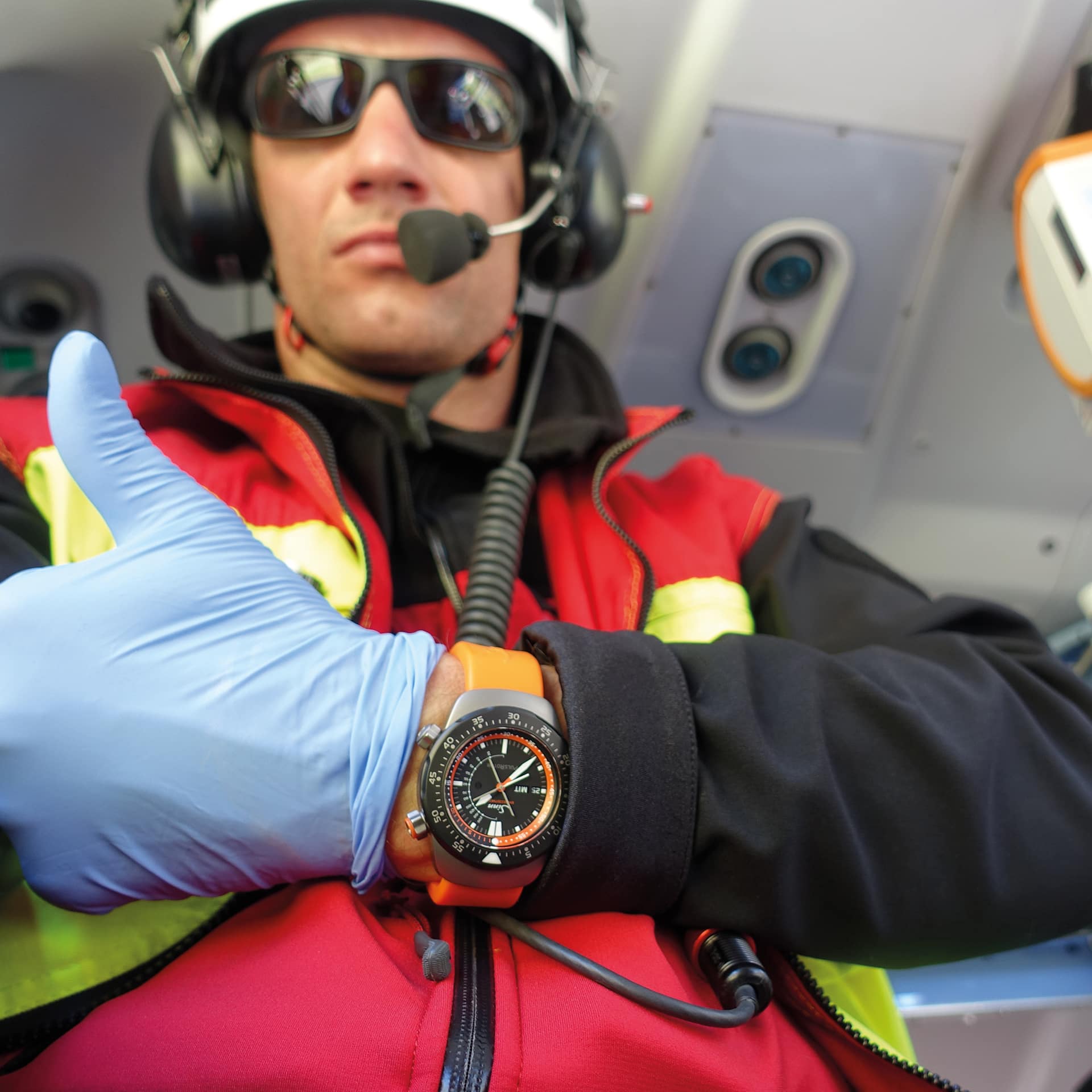At home all over the world – but especially in the mountains
Emergency doctor Martin Leitl with the EZM 12 in the Alpine air rescue service
Bernese Oberland, Switzerland. The rescue helicopter is still on the ground. Emergency doctor Martin Leitl is waiting for his first assignment on this autumn day in the magnificent Alpine landscape. When the emergency signal sounds, he takes off with his pilot and a paramedic. Their mission is always the same: to save injured hikers, mountain climbers, skiers or paragliders from precarious situations. Martin Leitl has been part of these rescue operations since 2013. But they are just one focal point in his hitherto multifaceted life.

Besides being an emergency doctor, he is also an internist, a Master of Peace and Security Studies, as well as a state-approved mountain and ski guide. Martin Leitl refers to himself as ‘a totally regular guy with a rather unusual background’. That’s for sure! For behind such impressive titles lies an eventful life story.

Born (in 1975) and raised in Plattling on the edge of the Bavarian Forest, he was forced out into the big wide world after completing his national service and medical studies: accompanied by his rucksack and like-minded people, as a volunteer on deployments abroad with the German Armed Forces (ISAF, KFOR), and with the humanitarian organisation Doctors Without Borders. The list of countries he has visited over the years is impressive. Those who read it invariably find themselves picturing Martin Leitl as an inquisitive, open-minded individual. Yet he doesn’t consider himself a daredevil or extreme adventurer. One thing that has remained constant throughout his life is his great interest in a wide range of activities and a passionate curiosity of the world, which he has always followed. His keenness to travel no doubt came from his father, who led the expeditions of the local Alpine association into the wilds of Kurdistan, across the Ararat towards West Greenland.
An interest in trouble spots and conflicts
Remarkably, it is this curiosity that continued to draw him to conflict zones, in particular, in Africa and the Middle East. Why is that? ‘Naturally, I wanted to help. At the same time, I wanted to find out what was actually behind these conflicts. How do these people think and feel? I wanted to get to know the countries first-hand and see things from my own fresh perspective. You can only truly understand why something has happened once you are actually there. Whether as a private individual, a medic or an aid worker’, he says.
Practising as a doctor and mountain guide
However, the constant commute between his home and distant lands, not to mention some of the terrible experiences he went through on foreign missions, left their mark – gradually leading him to rethink things. Is this life really good in the long run for my inner equilibrium? Am I all too often looking into the darkest abysses of humankind? Is a ‘career’ in humanitarian aid really the ultimate goal under such circumstances? Martin Leitl found his own answers.
EZM 12: on a mountain rescue mission
Aside from his keenness to travel, another thing has always fascinated Martin Leitl: mechanical watches. To him, they are quite literally an expression of craftsmanship, soul and quality. He believes mechanical watches to be very personal items. They are a joy to wear and something that can be passed down to future generations.
His quest to find a reliable watch led him to the EZM 12, a mission timer specially designed for the air rescue service and thus ideal for an emergency doctor such as himself. He appreciates the watch’s durability, functionality and focus on the essentials. ‘The EZM 12 is well designed and very harmonious, especially in terms of functionality’, he says in summary. ‘It’s a pleasure working with the watch. The time measurement function with count-up inner rotating bezel and countdown outer rotating bezel makes it especially easy to use.’ After all, every rescue mission is a race against time. Wherever a rescue helicopter lands, every minute counts. ‘When did I get to the patient? When did I administer medication? How long did I spend resuscitating? As an emergency doctor, these are all questions that need answering fast. This makes it all the more important to be able to keep an eye on the time. The EZM 12 optimally assists me’, says Martin Leitl, highlighting the benefits of this powerful tool for his work in mountain rescue.

In other words, optimal conditions for the EZM 12 to prove itself on another extraordinary mission. For Martin Leitl it was his second mission to Antarctica, once again on behalf of the Alfred Wegener Institute. His skills as a doctor and mountain guide were put to the test on this research expedition, too. Another mission timer also weathered and ultimately succeeded brilliantly in mastering the extreme conditions: the EZM 10, which accompanied him on his first research expedition to Antarctica.

Martin Leitl has seen much of the world, with all its beauty and fascination – but all too often things that also weigh heavily on the heart and soul.
Africa: Burkina Faso, Ivory Coast, Ghana, Guinea, Cameroon, Liberia, Mali, Namibia, Niger, Nigeria, Rwanda, Sudan, South Africa, Central African Republic
Middle East / Asia: Afghanistan, Egypt, Georgia, Iran, Israel/Palestinian territories, Jordan, Kyrgyzstan, Lebanon, Morocco, Syria, Tajikistan, Turkey, United Arab Emirates
America: Alaska, Argentina, Bolivia, Brazil, Chile, Guatemala, Guadeloupe, Peru, Uruguay
Polar regions: Greenland, Northern Norway, Svalbard, Antarctica
More information at www.fernsicht.org

